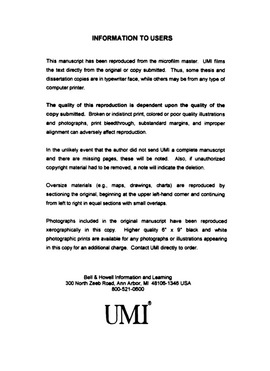| dc.contributor.advisor | Ashby, Michael, | en_US |
| dc.contributor.author | Asirvatham, Victor Sam. | en_US |
| dc.date.accessioned | 2013-08-16T12:30:59Z | |
| dc.date.available | 2013-08-16T12:30:59Z | |
| dc.date.issued | 2000 | en_US |
| dc.identifier.uri | https://hdl.handle.net/11244/6005 | |
| dc.description.abstract | The mechanism of protonation of (eta6-C6H 6)Mo(TRIPOD) (1) (TRIPOD = tris(1,1,1-diphenylphosphinoethyl)methyl ethane) to give [(eta6-C6H6)MoH(TRIPOD)] + was reported to involve a cyclohexadienyl intermediate. In this project, the basis of this unusual mechanism was probed by studying the electronic structure of eta6-C6H6)Mo(TRIPOD) using experimental and theoretical methods. Gas phase photoelectron spectra indicate that the highest occupied molecular orbital of (eta6-C 6H6)Mo(TRIPOD) is metal based with sizable arene character. The theoretical calculations augment the experimental results. One electron oxidation of 1 yields [(eta6-C6H 6)Mo(TRIPOD)]+ (1+), the electron paramagnetic resonance spectra of which shows phosphorus and arene hyperfine coupling (hfc). The presence of arene hfc indicates arene character in the singly occupied molecular orbital of 1+. Experimental and theoretical studies of 1 and related model compounds reveal the initial protonation of these compounds takes place at the metal-based frontier orbital with substantial arene character. Electrophilic substitution reactions of 1 with various electrophiles were attempted to understand the effect on the mechanism by electrophiles bulkier than proton. The electrophilic methylation of 1 was studied in detail. A mixture of methylated hydride, [(eta6-C6H5Me)MoH(TRIPOD)] + and unmethylated hydride, [(eta6-C6H 6)MoH(TRIPOD)]+ were formed in methylation reactions. Electrophilic reaction of [CH2 = NMe2]+ with 1 gives the ring substituted product, [(eta6-C 6H5CH2NMe2)MoH(TRIPOD)]+. Although attempts to isolate the product proved unsuccessful, spectroscopic evidence shows the ring-substituted complex as the only product. The effect of arene ring functionalization on the aromatic electrophilic substitution was studied by protonation of alkylarene derivatives of (eta6-C 6H6)Mo(TRIPOD). In conclusion, the mechanism of protonation observed for 1 is governed by its stereoelectronic factors, but not general for (eta6-arene)M(phosphine)3 complexes. (Abstract shortened by UMI.) | en_US |
| dc.format.extent | xv, 181 leaves : | en_US |
| dc.subject | Chemistry, Inorganic. | en_US |
| dc.subject | Chemistry, Organic. | en_US |
| dc.subject | Phosphine. | en_US |
| dc.subject | Substitution reactions. | en_US |
| dc.subject | Aromatic compounds. | en_US |
| dc.title | Mechanisms of electrophilic aromatic substitution reactions of (eta('6)-arene)molybdenum(phosphine)(, 3) complexes. | en_US |
| dc.type | Thesis | en_US |
| dc.thesis.degree | Ph.D. | en_US |
| dc.thesis.degreeDiscipline | Department of Chemistry and Biochemistry | en_US |
| dc.note | Major Professor: Michael Ashby. | en_US |
| dc.note | Source: Dissertation Abstracts International, Volume: 61-06, Section: B, page: 3055. | en_US |
| ou.identifier | (UMI)AAI9977947 | en_US |
| ou.group | College of Arts and Sciences::Department of Chemistry and Biochemistry | |
